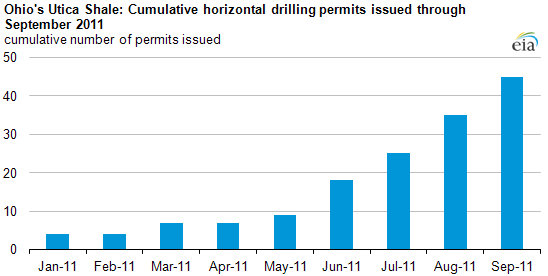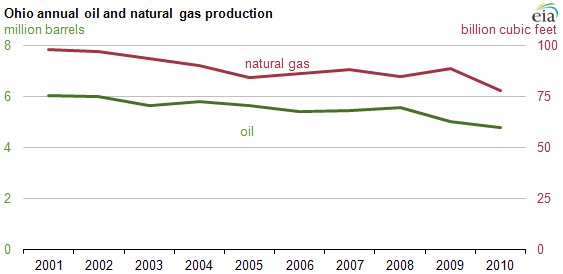
Oil and natural gas drilling in Ohio on the rise

Download CSV Data
Escalating industry interest in the Utica Shale, which lies under the more familiar Marcellus shale and covers a wider geographic area, may boost Ohio into the ranks of U.S. States with significant increases in oil and natural gas production from horizontal drilling in shale formations. Although production volumes are still small, the number of Utica-targeted horizontal drilling permits issued to Ohio operators from January through September 2011 rose more than twenty-fold over full-year 2010.
Ohio is not presently among the U.S. States experiencing significant oil and natural gas production increases from drilling in shale formations. Although the high-profile Marcellus Shale extends partially into Ohio, its more productive areas lie to the east, especially in Pennsylvania, where most of the exploration and development activity is centered. However, the underlying Utica Shale, which covers much of Ohio and parts of several other States from New York to Tennessee, offers considerable potential.
In eastern Ohio, the Utica is thought to be relatively rich in oil and natural gas liquids that are currently worth significantly more than natural gas on an energy-equivalent basis. Preliminary estimates by Ohio's Department of Natural Resources (ODNR) suggest a recoverable reserve potential of between 1.3 and 5.5 billion barrels of oil as well as 3.8 to 15.7 trillion cubic feet of natural gas. Industry interest in the Utica is already apparent: from January through September 2011, ODNR issued a total of 42 permits for drilling horizontal wells in Ohio's portion of the Utica Shale. In sharp contrast, only 2 such permits were issued in all of 2010.
Recent major acreage acquisitions also underscore the industry's budding interest in Ohio's slice of the Utica. In September, Hess Corporation announced its $750 million acquisition of Marquette Exploration LLC, which included a 100% interest in 85,000 acres. The Marquette purchase fell closely on the heels of another deal in which Hess paid $593 million to CONSOL Energy for a 50% stake in about 200,000 acres. Hess' deals follow a series of transactions though which Chesapeake Energy amassed 1.25 million acres at a reported cost of between $1.5 billion and $2 billion.

Download CSV Data
Ohio's oil and natural gas production has been fairly flat in recent years, with annual production averaging about 5.5 million barrels and 89.0 billion cubic feet, respectively, over the last ten years (see chart). The extent to which the Utica Shale will contribute to Ohio's oil and natural gas production remains to be seen.
Shale-focused exploration and development in some States has significantly boosted production. North Dakota, for example, has become the Nation's fourth largest oil-producing State, due in large part to horizontal drilling in its portion of the Bakken Shale formation. Similarly, Pennsylvania's natural gas production has grown substantially with accelerating horizontal drilling in the Marcellus. According to the Pennsylvania Department of Environmental Protection, total natural gas production in 2009 was about 288 billion cubic feet (Bcf). In the first half of 2011, natural gas production from the Pennsylvania portion of the Marcellus alone was about 435 Bcf, with full-year production likely to approach one trillion cubic feet.
Tags: Colorado, liquid fuels, Marcellus, natural gas, Ohio, oil/petroleum, shale, states, Utica